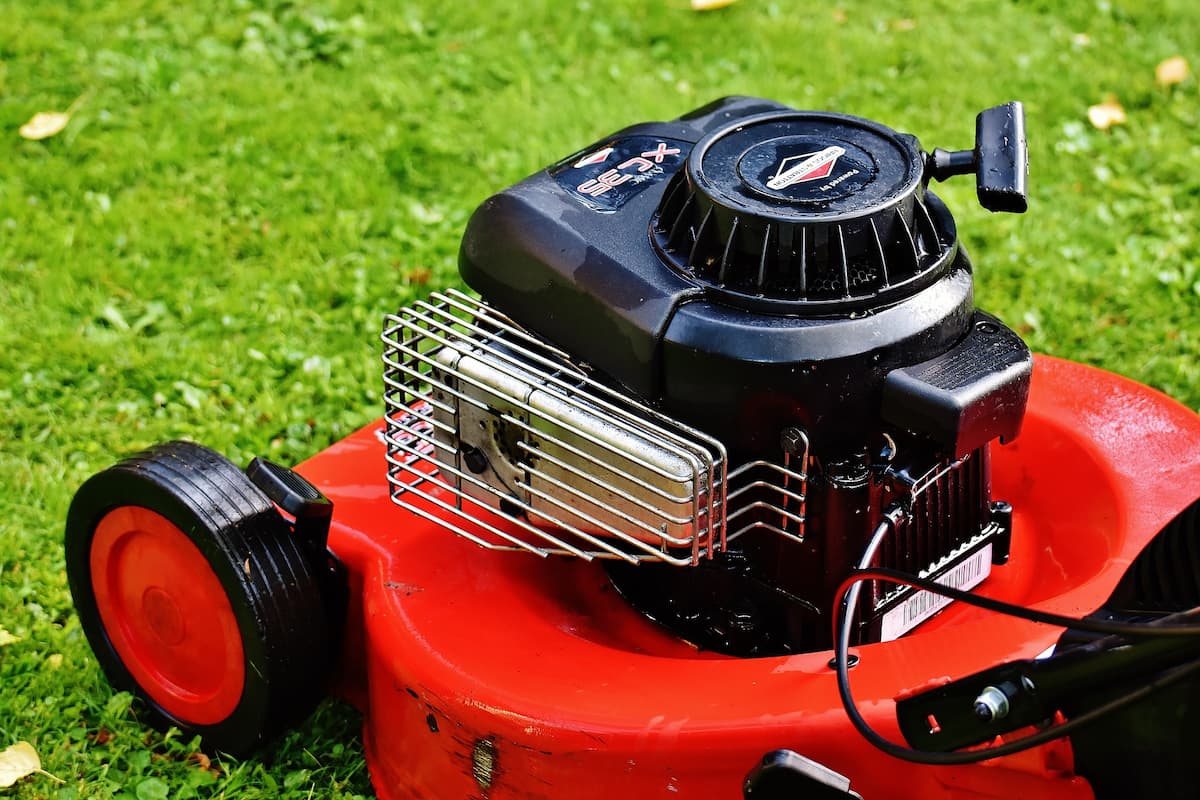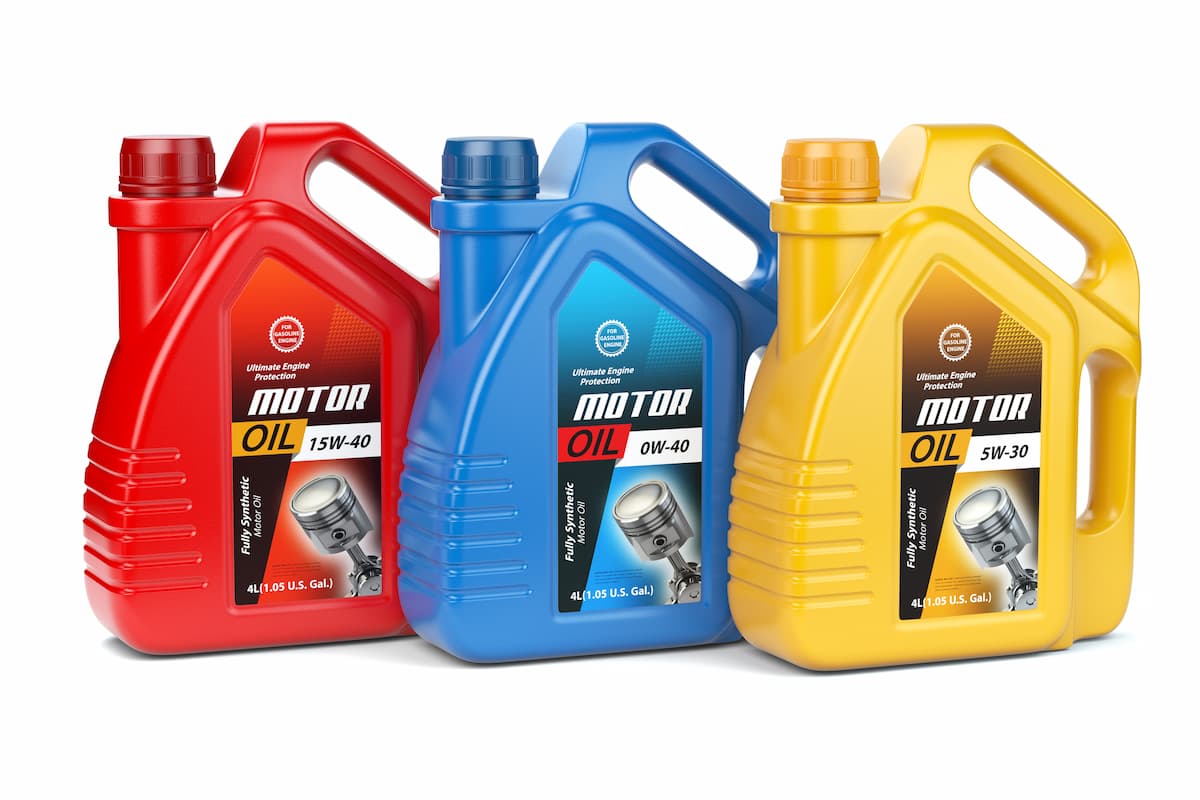Is Car Oil The Same As Lawn Mower Oil?
Cars and lawnmowers run on engines, so it’s common to wonder if the oils are interchangeable.
Though they are, you have to consider specific factors.
Car oil is similar to lawn mower oil, and you can use it in lawn mowers with four-stroke engines. However, car oil has a high concentration of additives and can damage smaller engines. It’s also important to match base oils; otherwise, you risk damaging your lawn mower’s motor.
Using the correct conventional motor oil in your lawn mower will get the job done, but you must check your engine specifications to confirm its compatibility.
Always confirm the information in your owner’s manual before proceeding with an oil change. You can double-check the manufacturer’s website if you don’t have your manual.
Lawn Mower Engine Types

The engines in lawnmowers are either two-stroke or four-stroke engines, and each requires a different type of oil for proper functioning.
Two-Stroke Engines
Smaller lawnmowers typically run on two-stroke engines. These lawn tools are less expensive than four-stroke mowers but have specific drawbacks and limitations.
Two-stroke engines are not as popular because they produce more harmful emissions and are more costly to maintain.
Firstly, two-stroke lawnmowers are not fuel-efficient, burning more oil over the same distance as a four-stroke engine.
Secondly, these mowers require expensive, high-quality oil to operate efficiently, and using the wrong oil can cause poor lubrication and reduce performance.
You can purchase the recommended two-cycle oil from the manufacturer. If you can’t find it, refer to your owner’s manual for a list of other lightweight oils appropriate for your lawn mower.
Four-Stroke Engines
Lawnmowers with four-stroke engines are more expensive and complex than those with two-stroke motors; however, they’re more fuel efficient, durable, and flexible with oil type, making them cheaper to maintain.
Though simpler, a four-stroke engine in a lawn mower is similar to that of a regular car engine, so it’s no surprise that motor oil is an acceptable lubricant.
Both machines use two types of oils: conventional oils (containing petroleum) and synthetic oils (without petroleum).
When using motor oil in your lawn mower, use SAE 30 or 10W-30 oil. If using synthetic oil, make sure that it aligns with SAE standards.
Just bear in mind that a mower engine is smaller than a car motor so before using motor oil in your lawn mower, confirm it can handle the additives.
Check your owner’s manual if you’re not sure about oil compatibility.
Can You Use Car Oil in a Lawn Mower?
You can use car oil in a four-stroke lawn mower but not in a two-stroke engine. Any lubricant must meet engine specifications, or you risk damaging the motor.
Car oil doesn’t increase your mower’s performance, but it’s a reasonable alternative if you run out of your manufacturer’s specified lubricant.
The opposite is true of two-stroke lawnmowers, which require lighter (thinner) engine oils.
The thickness of car oil can clog two-stroke engines, impacting the power supply. The effects may not be noticeable at first, but you will eventually see a decline in performance.
Over time, using the incorrect oil in your lawn mower may damage it beyond repair.
Four-stroke mowers will function using car oil, but choosing motor oil with incompatible base oils or high additive concentrations can also damage your four-stroke engine.
The deterioration is slow, however, so you can mitigate any damage.
How Different Is Synthetic Oil From Conventional Oil?

Synthetic oil is more refined than conventional oil and is usually the best oil for any engine (not just lawnmowers).
Synthetic oils have significant effects on performance. The higher quality base oils make them more chemically stable and more difficult to lose their protective qualities.
The difference between synthetic oil and conventional oil occurs during refining.
Synthetic lubricants go through a comprehensive process that removes as many impurities as possible. The final product is stronger, providing improved flow and better protection against wear.
When using synthetic oil in your lawn mower, confirm it meets engine specifications.
What is the Best Lawn Mower Oil?
Two-stroke engines require “small engine oils,” as specified by manufacturers. They can also use lubricants geared toward air-cooled engines, like those in chainsaws and weed eaters.
Four-stroke engines can use automobile oils, and the standard SAE 30 is one of the best. It’s also the most ideal for higher temperatures.
Other acceptable oils include:
- SAE 10W-30 – better for colder temperatures, but expect higher oil consumption.
- SAE 5W-30 – better for very cold or extreme weather conditions.
- Synthetic SAE 5W-30 – works in all weather conditions and provides better protection against wear.
Avoid using additives in your oil – they can damage your engine.
If the manufacturer recommends them, follow their instructions. For example, if your manufacturer recommends detergent oils, you shouldn’t get a lubricant with friction modifiers.
When Should You Change Lawn Mower Oil?

Only four-stroke lawnmowers allow you to change the oil. When purchasing a new one, you’ll want to change the oil after the first three to five hours of use.
Initially, as the motor runs, internal components release shavings into the lubricant. Accumulating these fillings might raise the wear rate, so you’ll need to replace the oil sooner.
After you’ve had your mower for a while, the oil change intervals will depend on the type of lawn mower:
- Walk-behind mowers – every 50 hours of use
- Riding mowers – every 100 hours of use.
You can also change the oil every season. The process is simple, but it’s always recommended to refer to your owner’s manual for guidance.
Key Pointers For Changing Lawn Mower Oil
Check the Dipstick
A dipstick is a long tube with markings that inform you of the oil level.
The oil level should be between the “add” and “full” pointers. When it’s below the “add” mark, it’s time to add oil.
Use a funnel to avoid spilling, and do not go above the “full” mark to prevent overheating.
Run the Engine Before Adding New Oil
Before removing the old oil, you can run the engine for three to five minutes to reduce the lubricant thickness.
Going over five minutes may make the oil hotter, so keep an eye on your motor.
Once the oil is out, remove the spark plug and spark plug lead so the engine doesn’t accidentally run while adding the new lubricant.
Drain the Oil
You can empty the oil in your lawn mower through the drain plug, dipstick plug, or using an oil extractor kit.
Most manufacturers require you to tilt the mower to its side when using the drain plug. If so, do it with the fuel tap turned off to reduce the chance of a fire.
For a more efficient method, use an oil extractor kit. All you need to do is put the tube inside the tank and siphon out the lubricant.
Conclusion
Car oil and lawn mower oil are not that different but using them interchangeably is not straightforward.
You can only use automotive oil in a lawn mower with a four-stroke engine. Additionally, base oils and additive concentrations should be compatible to avoid clogging.
For optimal engine performance, use synthetic oils. They have fewer impurities than petroleum-based conventional oils, increasing the service life of your lawn mower.
Always check your owner’s manual before using a new oil to confirm it’s appropriate for your engine.






